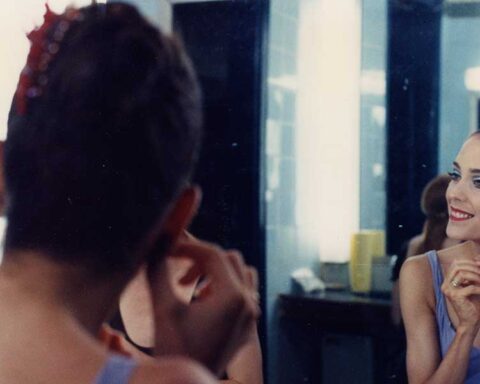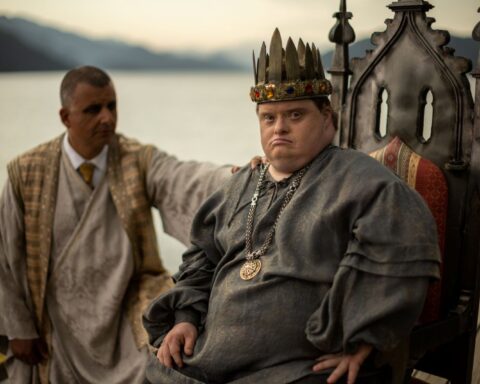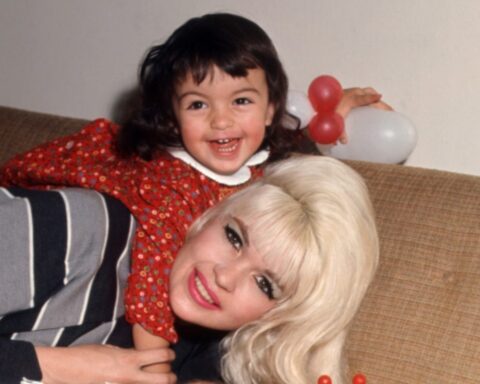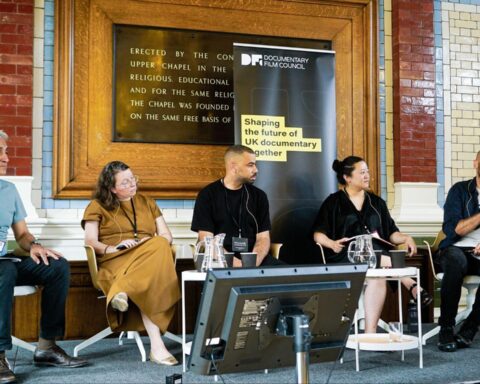The name Leonard Retel Helmrich is not one that slips off the tongue easily, but it is one that is becoming more familiar to lovers of long-form, auteur documentaries. It belongs to a Dutch Indonesian filmmaker with a unique, coherent body of work, who presents windows—or perhaps more accurately, magnifying glasses— onto micro-worlds of the two countries he calls home.
Audiences in Montreal were able to meet Leonard Retel Helmrich this fall, as a guest of both the Cinémathèque québécoise, where a retrospective of his work took place, and at the Rencontres internationales du documentaire de Montréal (www.ridm.qc.ca), where he gave a master class and screened his most recent work Promised Paradise.
Born in Holland of a Javanese mother and “an old colonial Dutch person,” as he describes his father, Retel Helmrich set out to discover his mother’s country after her death in 1990. While his early films are noteworthy, it is Retel Helmrich’s more recent work, in which he aims to bring Indonesian society to a Western public and presumably come to terms with half of his birthright, that has given him international recognition.
Eye of the Day (2002) and Shape of the Moon (2004) are the first two installments in what is to be a triptych, a portrait of one family struggling in modern Indonesia. Shape of the Moon won several awards, including the World Cinema Documentary Competition at the 2005 Sundance Film Festival and the Joris Ivens Award at IDFA (International Documentary Filmfestival Amsterdam) in 2004. They secured Retel Helmrich’s place as a documentary innovator who nonetheless credits illustrious forbearers for his inspiration. He hopes to complete the third installment, Shape of the Stars, in 2009.
Retel Helmrich’s first major film, Moving Objects (1991), was a fascinating behind-the- scenes look at the world of puppetry, focusing on six of the 60 Puppet, Object and Visual theatre groups in Holland. The film also revealed his penchant for camera wizardry, with an opening shot that tilts up from two puppet fish swimming in black space to emerge on the surface of a pond where two grizzled puppeteers are fishing. And it is a world close to a certain documentary genre, as one character says: “The puppeteer wants to create the illusion that the puppet is alive…and get the audience to forget about the material.”
Moving Objects was a foundation stone for Helmrich’s later films. He talks about the connection between puppetry and filmmaking: “The moment the puppeteer handles the puppet, he himself really believes it is alive. That feeling omes through the movements of the puppet…originating from the hands of the puppeteer. His whole heart, compassion, empathy and love are expressed by the movements of his hands moving the puppet…. The same thing counts for the camera…. When the camera-operator moves the camera from his heart and feels compassion, empathy and love towards the person he is filming, this feeling will come through to the audience.”
In Jemand Auf der Treppe (1994), Helmrich takes his interest in theatre and camera technique further, shooting a 40- minute performance by two of the participants in his earlier film, in a single take. The piece is a combination of non- narrative theatre and concrete music played on a wide range of homemade mechanical sound devices and re-tooled instruments. While the whole film is impressive, the opening is signature Helmrich virtuosity. The actors first appear on a TV screen, until the camera lifts up and travels smoothly over the television towards a tabletop. At the last second, it slips under the table and continues traveling — or more accurately “flying” — past various objects until an actor enters the frame. The shooting was done with an HDTV camera, then still an experimental medium, mounted on a specially designed super-mobile crane.
Retel Helmrich calls his filming approach single shot cinema, “a way of filming that enables you to shoot a scene in one single shot using just one camera . . . in order to have all the different camera angles that express your personal feelings and perception of that moment.” The technical apparatus includes an elaborate steadicam system with fingertip camera controls and a small light camera, which together allow continuous motion shooting to really make use of the three dimensions of space. Though hardly an invention, single-shot cinema has largely been used in the world of fiction. Hitchcock’s Rope, Sokurov’s The Russian Ark, the opening of Welles’ Touch of Evil, are among the most renowned instances of the technique, which has rarely been used in documentary. (For really dazzling examples of Retel Helmrich’s “steadywings” technique, check out www.singleshotcinema.com, where his extraordinary style is on view.)
A theoretical foundation underpins this way of working, much of it credited to French theorist André Bazin, high priest of realism and exponent of the use of wide angle lenses and long takes. Retel Helmrich was particularly inspired by Bazin’s dictum that the essence of film is the movement of the camera.
He is close to the aesthetic of fellow Dutchman Joris Ivens. Shots of rain are common tropes in his films, in homage to Ivens’ famed film of the same title, as are shots of details in nature—insects, raindrops, shafts of sunlight—that punctuate with still intensity the flowing, non-stop wide shots of his films. Like Ivens as well, he travels enormously, lecturing and giving workshops in countries all over the world.
Retel Helmrich’s practice also calls to mind the work of Cartier-Bresson and his “decisive moment.” He puts it this way: “When I film,… I always try to capture the whole situation in one shot and express the emotion of the moment in that one single shot.”
He makes camera movement his major means of cinematographic expression. For him, content and form are not separable, as the camera is a direct expression of the filmmaker’s feelings toward his or her subjects. His apparatus incontestably allows for some jaw-dropping shots and his visual inventiveness seems boundless, but the substance and power of his films come from the most basic and time-tested of documentary work: good research, an empathy that allows him to develop relationships of trust and complicity with his characters, an eye for telling details, a poetic stance vis à vis the real.
In his “Indonesia Suite” Helmrich has found his voice as a filmmaker, perhaps because of the emotional weight of the situations he is filming and the characters with whom he develops close relationships. Through the eyes and lives of the characters, we gain a glimmer of understanding of the complex, explosive mix that is Indonesian society.
In Eye of the Day, the film that really introduced Helmrich to Western audiences, we first meet the central character Rumidjah, mother of three adults, as she shoves her way through a dense, excited crowd in Jakarta, trying to get a share of the rice being doled out from the back of a truck. The shot is a metonym of the film’s overall themes, and of Retel Helmrich’s take on Indonesian society: there’s poverty, political chaos, the struggle for survival and terrible harshness of urban life, and a growing rural-urban divide.
Rumidjah, her daughter, two sons and granddaughter live in one of Jakarta’s cramped, densely populated neighborhoods, where privacy is at a minimum. They are not destitute, but everything is a struggle. Rumidjah and her daughter travel many hours by train to her native village to work on the harvest and return with rice and chickens to “help get by.”
Religion is a major theme of the film, from its opening shot: a dawn landscape with the voice of the muezzin proclaiming, “Allah is great.” The film shows worship as a powerful unifying force, but also as divisive and exploitative. Rumidjah is a Christian within a largely Muslim family and country. Her oldest son has converted to Islam, and we feel the pressure on her remaining son and daughter. Religion consoles people who struggle for the most basic amenities of life and what little cash they have goes towards fulfilling religious obligations.
Two scenes with Rumidjah’s daughter and son-in-law speak volumes. We first watch as she cooks and serves anevening meal to several dozen religious acolytes, and pays for the services of the imam who led the prayer meeting, before falling into bed, exhausted. In the next scene, we see husband and wife in pre- dawn darkness, gathering picks, torches and baskets, before heading out for a day on Jakarta’s steaming garbage dump.
In Shape of the Moon, Retel Helmrich’s most accomplished work, Rumidjah makes a difficult decision to return to her birthplace in Central Java, in the hope of spending her old age in easier circumstances than she faces in Jakarta. One son has married and moved out. We also learn that her daughter has died, leaving Rumidjah to be her granddaughter’s guardian.
Religion remains a central, constant source of order, tension and contradiction. Young children read ghastly, illustrated stories of death, torture and retribution in holy tomes, while Bakti, Rumidjah’s remaining unmarried son, leads his ne’er-do-well life of gambling, drinking, womanizing… and pigeon-raising. Some time later, he finds a wife and converts to Islam.
Frequent shots of Muslim worship are reminders of Rumidjah’s struggle to sustain her faith. We see her making a contribution to a door-to-door solicitor collecting money for a new speaker for a local mosque. A little while later, during Ramadan, in a bitterly comic follow-up, Rumidjah sits at home with her grand- daughter and the muezzin’s call to prayer is deafening. But, when she finally moves to the countryside, we see her and a Muslim male relative praying at the grave of their common ancestor. In the countryside it seems, God and Allah are more peripheral, or at least integrated into a more syncretic form of faith.
Extortion is also a way of life. Rumidjah is prey to an unscrupulous moneylender in a remarkable scene in which their tense discussion about repayment is interlaced with extreme close-ups of a deadly game between geckos and insects. The film’s superb sound design lets us hear a faint crunching as the gecko chews its prey, before we witness another gecko attacking his brother for a share of the feast.
While the films are unsparing in their social criticism, they also feature scenes of people uniting to help each other, as in one dramatic sequence in Shape of the Moon where fire rages through a large swath of the cramped, mostly wooden dwellings in Rumidjah’s neighborhood, and everyone pitches in to help. Protests, demonstrations and elections are ubiquitous throughout both films, which were made in 1998 and ’99 during Suharto’s resignation and the subsequent election.
Trains feature prominently in both films, symbols of modernity but also of the past. In Shape of the Moon, we see various shots of a train bridge stretching across a luxuriant green valley, a beautiful construction harking back to colonial days, its filigreed, delicate structure an apparent metaphor of the fragile state of the country, and a symbol of the tenuous links that survive between rural and urban areas.
Trains thunder through squatter-like quarters of Jakarta, dwarfing the fragile dwellings, and barrel through slightly wealthier areas, close enough to the houses to shake hands. People ride in trains, many ride on top, or stand on outside platforms, desperately clutching handrails. In Eye of the Day, a country guitar-strumming youth sings an anti-Suharto ditty detailing his various failings.
Retel Helmrich strays from Bazin’s purist approach in that his technical prowess with the camera often gets in the way of the flow of reality. This isn’t a criticism but rather an observation: the camera acts in an almost Brechtian way, in a distancing rather than transparent manner. The train shot in Shape of the Moon most springs to mind here; it’s a technical tour de force in which we follow the steady, vertiginous walk of a man along the outside beam of the same bridge.
There are moments of redemption in his films, but no happy endings. When Rumidjah finally arrives in her new com- munity, one of its few Christian members, dozens of people turn up to help move her house to a more suitable location. It’s a stunning sequence. Later, she heads out with a relative to see about getting work on the harvest. They learn that most people are day laborers and there is not enough work to go around. The bitter truth is that Rumidjah has returned to an uncertain future and, perhaps, an impoverished old age. While life was difficult in the city, at least there were many small ways to make ends meet.
Commissioned by Dutch VPRO who wanted a film about the “mindset” of Indonesian people vis-à-vis terrorism, Promised Paradise (2006) is Retel- Helmrich’s most recent work. It follows Agus Nur Amal, a well-known troubadour-puppeteer and Indonesian griot, who declaims using a mix of song and recitation. Filmed following the Bali nightclub bombing in 2002, and during a time of several attacks in Jakarta, Amal is on a mission to decipher the inner feelings of a bomber, even while condemning such an act’s inhumanity.
In his quest, a vagabond by the name of Endang accompanies him and he consults with Leo Lumanto, a paranormal advisor. Fragments of a theatrical performance about war and peace are woven into the film in addition to Amal’s own outrageous puppet performance about terrorism and 9/11, featuring a flying fish and a hip-swaying Osama bin Laden wind-up doll. Remarkably, the audience reeling at the play’s dark humour is mostly made up of children. The film is a genre-bending satire reminiscent of the works of Israeli documentarian Avi Mograbi.
Promised Paradise reaches its climactic moment with Agus’ “interview” with the jailed Bali bomber, Iman Samudra. It’s a skillful bit of editing. While Samurda delivers a heartfelt Koran-based justification for planting a bomb in a Bali nightclub, the scene is intercut with generic images of local nightlife, including an embarrassing impromptu interview with an Australian dude on a motorcycle who has just picked up his “date” for the night. Though it hardly justifies the barbaric act, Helmrich does not allow us to feel complacent. A State that doesn’t care, and Westerners who have always treated the rest of the world as a natural resource playground are to blame as much as a deranged would-be religious leader.
Helmrich works in the best cinema vérité tradition, eschewing any voice-over commentary or narration. His characters do all the talking, and true to the realist aesthetic, he steers clear of fast-paced montage sequences, though he is not above some creative juggling with reality.
In Promised Paradise, Retel Helmrich has temporarily shifted away from his more personal works, returning to his roots in the theater, where the world is a stage and he is a puppet master. In addi- tion to the essential humanity that permeates his films, which transport us into realms so distant from our comfor- table North American lives, Retel Helmrich regales us with his keen eye and the sheer virtuosity of his camera work.








